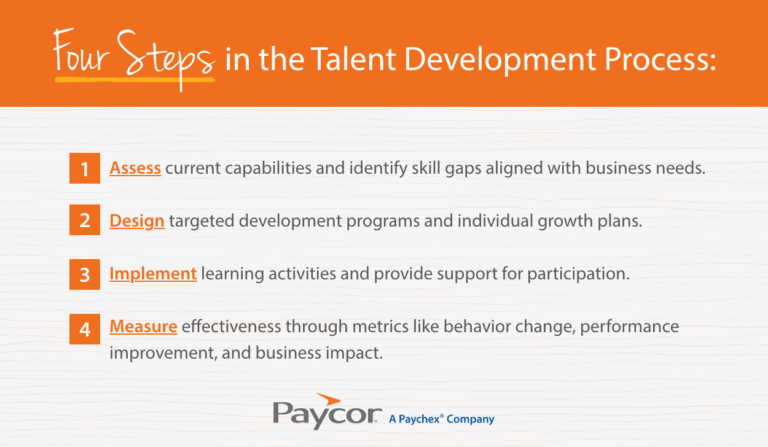The best organizations don’t just hire talent—they build it. In today’s competitive labor market, talent development is a strategic imperative. It’s the key to retention, engagement, and long-term business results.
Many HR leaders struggle to implement effective, proactive talent development programs. It’s time to close that gap. This article breaks down the details: what talent development is, why it matters, and how you can use it to transform your workplace.
What Is Talent Development?
Talent development is the strategic process of:
- Identifying employees’ strengths and skill gaps
- Providing educational and professional resources
- Expanding their capacity to meet current job requirements
- Aligning employee growth with future organizational needs
Unlike one-off training sessions, employee talent development takes a long-term view. An effective program invests in employees’ growth to build leadership pipelines and drive long-term business performance.
Talent development grows your employees’ careers and empowers HR to meet key objectives. Take retention, for example. 94% of employees would stay longer if their employer invested in their career development (LinkedIn Learning). That statistic should be a wake-up call for HR leaders in every industry.
Talent Development vs Talent Management
While often used interchangeably, talent development and talent management serve distinct but complementary functions within human capital managment. For instance:
Talent management is the umbrella strategy encompassing the entire employee lifecycle—from recruiting and onboarding to performance management, retention, and succession planning, including talent development. It’s the comprehensive approach to acquiring, deploying, and retaining workforce talent.
Talent development is one aspect of talent management. This is a specific focus area dedicated to nurturing your current employees, aligning their skills with future organizational needs.
Examples of Talent Development in the Workplace
Effective talent development takes many forms. These four approaches are common among high-achieving organizations.
Mentoring
Most mentoring programs pair less experienced employees with seasoned professionals who provide guidance, share institutional knowledge, and offer career advice. Unlike formal training modules, mentoring has a strong focus on relationships.
These personalized learning relationships address individual employees’ challenges and aspirations. Strong mentoring programs also accelerate onboarding, preserve institutional knowledge, and help emerging leaders navigate complex workplace dynamics.
Growth Plans
Employee development plans create structured roadmaps for employee advancement. These documented agreements outline specific skills to develop, milestones to achieve, and resources needed—all aligned with both the employee’s professional goals and organizational needs.
Effective professional development plans include clear timelines, measurable objectives, and regular check-ins to assess progress. They transform vague ideas into concrete action plans that drive real skill acquisition and career progression. When employees and managers build these plans collaboratively, they share accountability for each team member’s long-term development.
Learning
Educational programs—from online learning modules to technical certifications to leadership retreats—provide structured learning opportunities. These programs can include instructor-led training, online courses, workshops, conferences, and even tuition reimbursement for degrees.
The most effective learning initiatives tie directly to business objectives. If your company is implementing new technology, employees should learn the technology before the rollout. If you’re expanding into new markets, learning should focus on relevant competencies like cultural awareness.
Activities
Experiential learning invites employees to learn by doing, and has an immediate impact on your business. By offering stretch assignments, job rotations, cross-functional projects, and job shadowing, you encourage team members to build relationships and bust silos.
Professional development activities build skills through real-world application rather than classroom theory. This approach accelerates growth and appeals to a wide range of learning styles.
Why Is Developing Talent Important for an Organization
Organizations that recognize the importance of talent development gain measurable competitive advantages:
Improves Employee Retention
Turnover costs between 50% and 400% of an employee’s salary (HRMorning). Talent development directly addresses one of the main reasons employees leave: lack of career growth opportunities.
When employees see clear development pathways and feel their employer invests in their future, they’re significantly more likely to stay.
Builds Future Leadership Pipeline
The leadership gap is widening. As Baby Boomers retire and organizations grow, many companies face shortages of qualified leaders. Employee talent development creates internal leadership pipelines by preparing your rising stars to take on greater responsibilities.
Increases Employee Engagement
Engaged employees are more productive, deliver better customer experiences, and drive innovation. Yet only 32% of U.S. employees report feeling engaged at work (Gallup). Talent development is one of the most powerful strategies for HR to drive employee engagement.
Addresses Skill Gaps
The pace of change is accelerating in every arena, especially in terms of technological innovation, regulatory changes, and economic pressures. This trend has created a widening skill gap that recruiting alone can’t fix. Everyone in the workforce needs to learn new skills, including your employees.
Talent development programs are an investment in your team. When you upskill employees instead of hiring externally, you can cut down on recruiting and onboarding costs, retain organizational knowledge, and boost your overall retention rate.
Enhances Organizational Agility
Markets shift. Strategies pivot. Business models change, sometimes very rapidly. Organizations with strong talent development capabilities adapt faster because they already know how to develop talent in an organization and reskill their workforce.
When employees are accustomed to continuous learning and talent development, they’re more receptive to change. Your workforce becomes a strategic asset that can flex to accommodate business needs rather than a fixed cost structure that resists evolution.
Drives Business Performance
Researchers say, “talent + productivity = value” (McKinsey). Their data identifies several barriers to employee productivity, and the development of talent is at the top of the list. When HR addresses that issue, employees can accomplish more in a day, and companies flourish.
Strengthens Employer Brand
Your reputation as an employer matters; even more so in a tight labor market. Organizations known for investing in employee development attract higher-quality candidates and spend less on recruiting. Get it right, and job candidates will start to see your development program as a key differentiator. More than 50% of talent development professionals feel optimistic about the impact of their work (ATD). And when it comes to your employer brand, those opinions really do matter.
HR should stay current with talent development trends and best practices. Attend conferences, join professional networks, and learn from experts whenever possible. But most importantly, solicit ongoing feedback from participants, managers, and senior leaders. What’s working? What’s missing? What issues need your attention? Use your team’s input to keep up with the changing times.
Talent Development Strategy & Process

An effective talent development strategy requires systematic planning, not ad hoc training. Follow these steps to create a talent development process that delivers results:
Align with Company Objectives
Start by identifying your organization’s top priorities for the next 3-5 years. What markets are you entering? What technologies are you adopting? What capabilities will differentiate you from competitors? Work with company leadership to make sure you understand the overarching strategy.
Your employee talent development strategy should directly support these business objectives. If your company is automating operations, train employees in process improvement and change management. If you’re expanding globally, focus on cultural competency and international business skills.
Assess Current Talent and Identify Gaps
Conduct thorough skill evaluations to understand your team’s capabilities. Then compare their current strengths with your projected future needs. HR will need to analyze performance data, conduct competency assessments, and gather information from managers to make an accurate assessment.
Identify key skill gaps that could prevent you from achieving business objectives, and prioritize gaps based on business impact and urgency. For example, a gap affecting your largest revenue stream or most critical customer segment demands immediate attention.
Design Targeted Development Programs
Use the data from your skills assessment to inform your talent development initiatives. Avoid generic, one-size-fits-all training. Instead, design customized programs that meet your team’s unique needs. For example, you might build:
- A first-time manager program for new supervisors
- A technical certification track for your engineering team
- An executive leadership module for high-potential directors
Each program should have clear learning objectives, defined success metrics, and appropriate delivery methods. The best development programs blend multiple approaches—like formal training, mentoring, and stretch assignments—to accommodate different learning styles.
Use Professional Development Programs
Leverage structured professional development programs to guide individual growth. This includes creating formalized development plans that document specific goals, activities, resources, and timelines.
Effective programs should span various areas of professional development—from technical skills and leadership capabilities to communication effectiveness and strategic thinking. Make sure you customize development pathways to align employees’ personal goals with the company’s long-term objectives.
Measure Employee Talent Development
Establish clear metrics to evaluate the effectiveness of your strategy. Track both engagement metrics (like participation rates, completion rates, and satisfaction scores) and business impact metrics (like retention, promotion rates, and ROI).
Use the data to continuously refine your approach. If a program shows low engagement or minimal impact, investigate why and make adjustments accordingly. Double down on initiatives that deliver a strong ROI; redesign the rest.
Update Your Strategy
Talent development isn’t a set-it-and-forget-it project. Business priorities will shift over time, and so will your employees’ goals. Review your talent development strategy at least once a year to ensure continued alignment with organizational needs.
How Paycor Helps with Talent Development
Paycor’s Talent Development Software empowers HR to support employees, achieve company goals, and drive sustainable results. Leaders can use our tools to communicate with employees about their specific goals, conduct performance reviews, and track their career growth.
By centralizing talent development within a comprehensive, integrated HCM solution, Paycor eliminates fragmentation and delivers a unified employee experience. Your entire approach, from identifying high performers to delivering training to measuring impact, can now operate from a single, integrated platform.
Develop Your Top Talent with Paycor
Your people are your competitive advantage, but only if you’re actively developing talent in the workplace. Paycor’s talent development tools give you the infrastructure to execute systematic, scalable programs that transform good employees into great ones. Stop losing high performers to companies that invest more in growth and start building a culture of development.
Learn how 30,000+ organizations trust Paycor to develop their talent and drive business performance. Request a guided product tour today.
Talent Development FAQs
Want to know more about talent development? Get the answers to HR’s most common questions below.
What is the meaning of talent development?
Talent development is the strategic process of building employee capabilities. This is typically HR’s responsibility. Effective talent development uses learning opportunities, experiences, mentorship, and growth planning to meet current and future organizational needs.
Is talent development the same as HR?
No, talent development is a specialized function within human resources. While HR encompasses all people-related activities—recruiting, compensation, benefits, compliance, and employee relations, among others—talent development specifically focuses on employee learning, growth, and capacity building. Many organizations have dedicated talent development teams within their larger HR departments.
What does a talent development manager do?
A talent development manager designs, implements, and oversees initiatives that develop employee skills. Their responsibilities typically include assessing organizational skill gaps, creating learning programs, running learning management systems, coordinating with external training providers, measuring program effectiveness, and partnering with business leaders to align development initiatives with strategic priorities.
What are some methods of talent development?
Common talent development methods include formal classroom or online training, mentorship, job rotations, stretch assignments, tuition reimbursement for external education, on-the-job training, and structured feedback through performance reviews.
What are the four steps in the talent development process?
While models vary, a typical talent development process includes:
1. Assess current capabilities and identify skill gaps aligned with business needs,
2. Design targeted development programs and individual growth plans
3. Implement learning activities and provide support for participation
4. Measure effectiveness through metrics like behavior change, performance improvement, and business impact.
Are talent management and talent development the same?
No, but they’re closely related. Talent management is HR’s comprehensive strategy for attracting, developing, and retaining talent across the entire employee lifecycle. Talent development is one component of talent management, specifically focused on employee education and career growth.
Are professional development and talent development the same?
The terms are often used interchangeably, but there’s a subtle distinction. Professional development typically involves activities that build skills and knowledge relevant to an individual’s profession or career.
Talent development usually focuses on building capabilities that serve both the employee’s growth and the organization’s strategic needs. Professional development is more focused on the individual, while talent development is more focused on the company.
What develops talent in the workplace?
Multiple factors develop talent: challenging assignments that stretch capabilities, quality relationships with managers and mentors, access to formal learning opportunities, an organizational culture that values growth and tolerates productive failure, clear career pathways that show advancement possibilities, and regular feedback that helps employees understand strengths and development areas.









